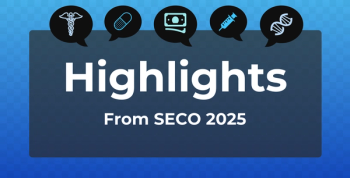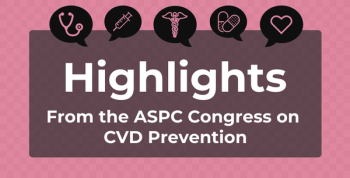
- June 2025
- Volume 31
- Issue Spec. No. 7
- Pages: SP398-SP399
Breast Cancer and the Use of Predictive Genomics
Key Takeaways
- Predictive genomics enhances breast cancer management by integrating predictive medicine, personal genomics, and translational bioinformatics for personalized care.
- Key applications include genome-wide association studies, polygenic risk scores, and pharmacogenetics, aiding in risk assessment and treatment personalization.
Breast cancer is the most common non–skin cancer among women in the United States.1 In 2025, more than 300,000 new cases of invasive breast cancer are expected to be diagnosed.2 Breast cancer is the second-leading cause of cancer death among women in the United States, behind lung cancer.3 When breast cancer is detected at its earliest stage, the 5-year relative survival rate is nearly 99%.4 Treatment involves multiple modalities tailored to the individual’s specific type and stage of cancer, including surgery, radiation therapy, chemotherapy, hormone therapy, and targeted therapy.
At a fundamental level, cancer cells develop when genetic changes occur within the cell that facilitate uncontrolled cell growth. One of the most significant advancements in cancer care in the 21st century has been the rapid expansion of knowledge in this area. A deeper understanding of specific cell pathways driving tumor growth facilitated a more personalized approach to treatment—providing the foundation to make some treatment decisions based on the genetic signature of a person’s cancer cells rather than taking a one-size-fits-all approach. This approach—using the individual’s genetic data to guide care—is predictive genomics.
Predictive genomics is an emerging area of medicine that brings together elements of the following5:
- PREDICTIVE MEDICINE: the use of data and advanced analytics to forecast individual health outcomes and guide personalized care
- PERSONAL GENOMICS: analysis of an individual’s genetic information to understand their unique traits, health risks, and potential responses to treatment
- TRANSLATIONAL BIOINFORMATICS: application of computational tools to convert biological data into practical insights and treatments
The goal of predictive genomics is to use genomic data to predict outcomes in complex and multifactorial clinical situations such as breast cancer. Predictive genomics can help with risk assessment, early detection of disease, and personalizing treatment.6,7 Key applications of predictive genomics include (1) genome-wide association studies8; (2) polygenic risk scores, which aggregate the effects of multiple genetic variants to estimate an individual’s genetic predisposition to a disease; and (3) pharmacogenetics, which provide an understanding of the genetic variants in medication metabolism that impact medication efficacy and toxicity.
Predictive Genomics in Breast Cancers
Predictive genomics in breast cancer falls into 2 broad categories: predictive genomics for risk reduction and predictive genomics for treatment planning.
RISK REDUCTION. One of many advances in breast cancer prevention and management has been a more robust characterization of germline genetic mutations that predispose individuals to develop breast cancer. BRCA1, BRCA2, PALB2, CHEK2, PTEN, TP53, and ATM gene mutations are known to predispose individuals to develop breast cancer. The presence of a germline mutation alone, however, does not guarantee that an individual will develop breast cancer. Predictive genomics helps refine quantification of an individual’s risk of developing breast cancer by combining additional data points. For example, data regarding an individual’s specific genetic variant —eg, women with a BRCA1 mutation have approximately a 60% lifetime risk of developing breast cancer—is combined with family history, lifestyle factors, reproductive history, and hormonal factors to make a more informed prediction.9-11 The refined risk score is then used for informed decision-making regarding risk-reduction strategies, which range from more aggressive screening protocols (eg, more frequent mammograms, use of MRI for screening) to risk-reduction surgeries (prophylactic mastectomy) to remove breast tissue before cancer can develop.
TREATMENT PLANNING. Scientific advancements in breast cancer treatment over the past decade have led to a deeper understanding of subgroups of patients. One of the ongoing challenges in the current era of breast cancer management is rightsizing cancer treatments to ensure that patients are neither under- nor overtreated.
TREATMENT CHOICE. One of the earliest applications of predictive genomics for breast cancer was the classification of estrogen receptor (ER) status. ER-positive (ER+) breast cancer cells express ERs on the cell surface, and cancer cells grow in response to estrogen. The expression of ERs is due to multiple factors, including gene expression (up- or downregulation of ER genes) and mutations in the ER gene.12 Since ER+ breast cancers grow in response to estrogen, medications and procedures that reduce the amount of estrogen in the body are an effective part of multimodal treatment of these tumors. Determination of the ER status of breast cancer is the gold standard and an essential part of treatment planning.
HER2 is a widely used and studied application of predictive genomics for breast cancer. Genetic mutations in the HER2 gene result in overexpression of the HER2 protein in breast cancer cells, leading to uncontrolled cell growth.13 HER2-positive (HER2+) breast cancer is more aggressive than HER2-negative breast cancer.14 There are multiple targeted treatments for HER2+ breast cancer, which are designed to block the HER2 protein to prevent further growth and spread of cancer. Examples of medications that are effective in patients with HER2+ breast cancer are trastuzumab (Herceptin), pertuzumab (Perjeta), and lapatinib (Tykerb). Determination of the HER2 status of breast cancer is the gold standard and an essential part of treatment planning.
Somatic breast cancer mutations in BRCA1 or BRCA2 are additional common genomic markers that drive therapeutic decisions. Cancer cells that harbor BRCA1 or BRCA2 mutations have impaired ability to repair DNA damage, resulting in genetic instability and an increased likelihood of cancerous transformations.15 PARP inhibitors further block DNA repair mechanisms, resulting in DNA damage that causes cell death.16 PARP inhibitors are particularly effective in tumors that have BRCA mutations. Examples of PARP inhibitors used in breast cancer are olaparib (Lynparza) and talazoparib (Talzenna). Select patients should undergo evaluation for BRCA status to determine whether PARP inhibitors are an appropriate part of their treatment plan.
TREATMENT BENEFIT. Genomic assays analyze the expression of multiple genes within a breast cancer tumor. For patients with early-stage breast cancer who have had surgery to remove the tumor and have no or limited cancer involvement in the axillary lymph nodes, genomic assays provide an additional data point to direct postsurgical treatment decisions. These tests quantify which specific genetic mutations are driving tumor growth. The genomic profile of the tumor is used to predict the risk of recurrence and delineate which patients are most likely to benefit from additional adjuvant treatment and which patients are not. Multiple commercially available assays are available (eg, Oncotype DX, MammaPrint, EndoPredict).
TREATMENT DOSE. As the field of predictive genomics evolves, an emerging field that impacts treatment planning is pharmacogenomics.
Pharmacogenomics is the study of how genetic variation in medication metabolism impacts medication toxicity and efficacy. For example, individuals with genetic variations in the CYP2D6 enzyme have altered metabolism of tamoxifen, a common medication used in ER+ breast cancer.17 Polymorphisms in CYP19A1 influence the efficacy of aromatase inhibitors, another common class of medications used in postmenopausal women with ER+ breast cancer.17 Individuals with polymorphisms in MDR1, responsible for transport of chemotherapy across cell membranes, experience higher levels of medication resistance and toxicity14. Understanding an individual patient’s ability to metabolize medications in their treatment program allows for dose adjustments or medication changes to ensure individuals have the greatest likelihood of deriving benefit from their medications while minimizing the risk of toxicity.
Challenges and Ethical Considerations
Genetic data are complex, and the science of the field is rapidly evolving. Widespread adoption and application of predictive genomics are limited by technical and ethical challenges. The complexity of genetic data requires a high level of technical expertise for appropriate interpretation. Genomic data alone are rarely adequate to make predictive determinations in breast cancer, instead requiring integration with clinical and environmental factors via sophisticated models. Many genomic studies have an ancestry bias, as data are often pulled from populations of European ancestry, which may not be readily translated to other groups.4 Before models are applied to prospective care decisions, they require extensive validation, including ensuring that diverse population data are used to avoid disparities in risk prediction.18
Integration of predictive genomics into routine clinical practice requires both an operational and educational infrastructure to ensure testing is being ordered and used correctly. Additionally, access to appropriate counseling to ensure patient understanding of this unique type of health data is necessary to deliver on the promise of predictive genomics at scale. There are additional data privacy concerns around handling, sharing, and storage of an individual’s genomic data. Informed consent about not only the testing but also the data storage plan is needed.19
Racial and ethnic minorities experience reduced access to predictive genomic testing and counseling. Many genomic tests are expensive and have variable coverage from insurance companies, making some testing cost prohibitive for patients. Additional cultural and social factors can influence willingness to undergo genetic testing.20
Future Directions
This area of medicine continues to hold promise for future advancements. There remains an ongoing and robust interest in further defining genomic profiles of difficult-to-treat disease to identify patients at highest risk for poor outcomes. The ultimate goal of defining the drivers of treatment-resistant disease is to identify novel treatment strategies.
As artificial intelligence (AI) capabilities continue to advance, there are opportunities to utilize the emerging technology in this area of healthcare. AI algorithms have the potential to not only analyze large volumes of genomic data and integrate additional data points but also to do so quickly and with increased accuracy. This has the potential to further refine the ability to provide personalized recommendations to individuals both for risk reduction and treatment of breast cancer.21
Conclusion
Predictive genomics plays a vital role in the prevention, diagnosis, and treatment of breast cancer. Past advancements in this area drive current gold standard treatment recommendations. Continued investment in this field is likely to further advance the ability to provide fine-tuned and personalized recommendations to individuals to optimize health outcomes.
Author Information
Sadie Dobrozsi, MD, MS, is the medical director of genetic testing and oncology imaging at Evolent.
References
1. National Cancer Institute. Breast cancer treatment. Cancer Trends Progress Report. U.S. Department of Health and Human Services. Retrieved May 21, 2025, https://progressreport.cancer.gov/treatment/breast_cancer
2. National Cancer Institute. SEER Cancer Stat Facts: Female Breast Cancer. Surveillance, Epidemiology, and End Results Program. Updated 2025. Accessed May 21, 2025. https://seer.cancer.gov/statfacts/html/breast.ht
3. Centers for Disease Control and Prevention. US cancer statistics female breast cancer stat bite. US Department of Health and Human Services. 2024. https://www.cdc.gov/united-states-cancer-statistics/publications/breast-cancer-stat-bite.html
4. Breast cancer facts & stats. National Breast Cancer Foundation. Updated April 1, 2025. Accessed May 7, 2025. https://www.nationalbreastcancer.org/breast-cancer-facts/
5. Baudhuin LM, Biesecker LG, Burke W, Green ED, Green RC. Predictive and precision medicine with genomic data. Clin Chem. 2020;66(1):33-41. doi:10.1373/clinchem.2019.304345
6. Abdou Y, Kantor O, Racz J, Newman L, Pierce LJ, Winer EP. Prognostic and predictive insights from genomic assays for breast cancer in diverse populations: a review. JAMA Oncol. Published online April 3, 2025. doi:10.1001/jamaoncol.2025.0178
7. Ren W, Yu Y, Wang T, et al. Comprehensive analysis of metabolism-related gene biomarkers reveals their impact on the diagnosis and prognosis of triple-negative breast cancer. BMC Cancer. 2025;25(1):668. doi:10.1186/s12885-025-14053-8
8. Palotie A, Metspalu A. Predictive genomics: disrupting healthcare from reactive to preemptive. Nature Research Custom Media webcast. May 10, 2021. Accessed May 7, 2025. https://www.nature.com/articles/d44224-023-00160-z
9. Breast cancer risk factors: inherited genetic mutations. Susan G. Komen. Updated December 19, 2024. Accessed May 7, 2025. https://www.komen.org/breast-cancer/risk-factor/gene-mutations-genetic-testing/inherited-genetic-mutations/
10. Other breast cancer genes. National Breast Cancer Foundation. Updated April 1, 2025. Accessed May 7, 2025. https://www.nationalbreastcancer.org/other-breast-cancer-genes/
11. Tyrer J, Duffy SW, Cuzick J. A breast cancer prediction model incorporating familial and personal risk factors. Stat Med. 2004;23(7):1111-1130. doi:10.1002/sim.1668
12. National Cancer Institute. HER2’s genetic link to breast cancer spurs development of new treatments. Cancer.gov. Updated 2023. Accessed May 21, 2025. https://www.cancer.gov/research/progress/discovery/her2
13. Dai X, Cheng H, Bai Z, Li J. Breast cancer cell line classification and its relevance with breast tumor subtyping. J Cancer. 2017;8(16):3131-3141. doi:10.7150/jca.18457
14. Giordano SH, Franzoi MAB, Temin S. Systemic therapy for advanced human epidermal growth factor receptor 2–positive breast cancer. J Clin Oncol. 2022;40(23):2612-2635. doi:10.1200/JCO.22.00519
15. BRCA gene changes: cancer risk and genetic testing fact sheet. National Cancer Institute. Updated July 19, 2024. Accessed May 7, 2025. https://www.cancer.gov/about-cancer/causes-prevention/genetics/brca-fact-sheet
16. Rose M, Burgess JT, O’Byrne K, Richard DJ, Bolderson E. PARP Inhibitors: clinical relevance, mechanisms of action and tumor resistance. Front Cell Dev Biol. 2020;8:564601. https://doi.org/10.3389/fcell.2020.564601
17. Tan SH, Lee SC, Goh BC, Wong J. Pharmacogenetics in breast cancer therapy. Clin Cancer Res. 2008;14(24):8027-8041. doi:10.1158/1078-0432.CCR-08-0993
18. Jafari M. Guan Y, Wedge DC, Ansari-Pour N. Re-evaluating experimental validation in the Big Data Era: a conceptual argument. Genome Biol. 2021;22(1):71. doi:10.1186/s13059-021-02292-4
19. Informed consent. National Human Genome Research Institute. Updated July 22, 2024. Accessed May 7, 2025. https://www.genome.gov/about-genomics/policy-issues/Informed-Consent
20. Advancing cancer genomics in public health. American Public Health Association. November 5, 2013. Accessed May 7, 2025. https://www.apha.org/policy-and-advocacy/public-health-policy-briefs/policy-database/2014/07/23/10/25/advancing-cancer-genomics-in-public-health
21. Tewari G. The future of AI: 5 things to expect in the next 10 years. Forbes. May 5, 2022. Accessed May 7, 2025. https://www.forbes.com/councils/forbesbusinesscouncil/2022/05/05/the-future-of-ai-5-things-to-expect-in-the-next-10-years/
Articles in this issue
Newsletter
Stay ahead of policy, cost, and value—subscribe to AJMC for expert insights at the intersection of clinical care and health economics.







































